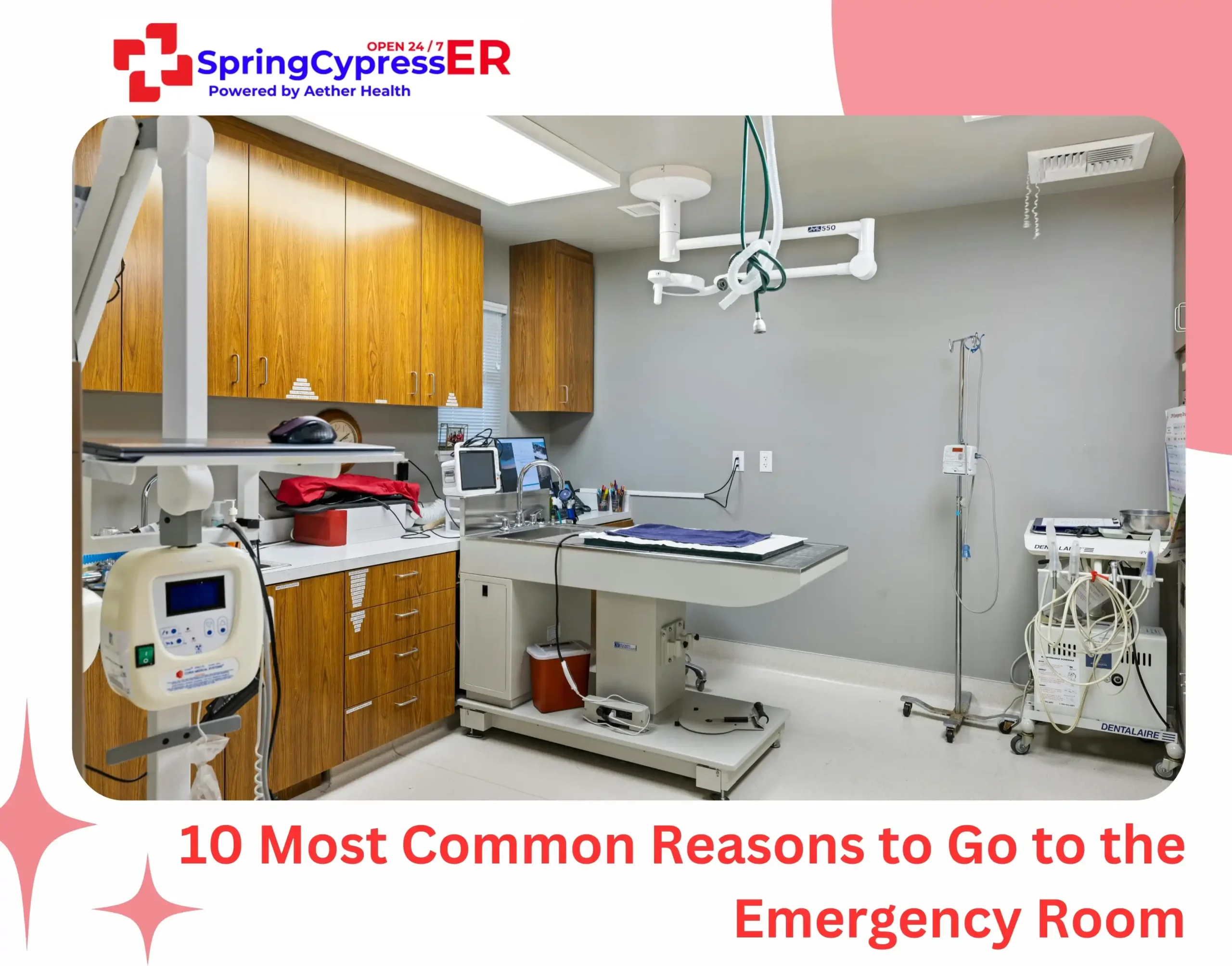Chest pain, breathing problems, severe injuries, stomach and abdominal pain consistently rank among the most common reasons for emergency room visits in the United States¹. As per CDC data, these symptoms account for millions of ER visits every year and often signal conditions that need urgent evaluation.
Knowing which symptoms require emergency care can help get the right treatment faster and avoid unnecessary costs. Let’s explore the most common ER visits and some serious emergencies you should never ignore.
10 Most Common Reasons to Go to the Emergency Room

1. Severe Abdominal Pain
The number one reason for emergency room visits in the US is stomach and abdominal pain. CDC data shows these symptoms make up for over 13 million visits to the emergency departments each year¹. It can range from harmless indigestion to serious conditions such as:
- Appendicitis
- Gallbladder attack
- Kidney stones
- Gastroenteritis
- Pancreatitis
If your stomach or abdominal pain is sharp, localized, or accompanied by vomiting or fever, it’s important to seek emergency care promptly.
2. Chest Pain
Chest pain is one of the most urgent symptoms seen in emergency departments. It can signal life-threatening conditions like heart attacks, angina, or pulmonary embolism. Warning signs include:
- Pressure or squeezing in the chest
- Pain spreading to the arm, jaw, or back
- Shortness of breath
- Nausea, sweating, or dizziness
Any unexplained chest pain should be treated as an emergency.
3. Cough
A persistent or severe cough often brings people to the ER. While many coughs are viral, it’s an emergency if you have:
- Trouble breathing or wheezing
- High fever
- Coughing up blood
- Chest tightness or pain
These symptoms can point to pneumonia, asthma flare-ups, or other lung infections.
4. Shortness of Breath
Difficulty breathing is another frequent reason for urgent care. Common causes include:
- Severe asthma attacks
- COPD flare-ups
- Pneumonia
- Allergic reactions (anaphylaxis)
- Pulmonary embolism (blood clot in the lungs)
Because breathing can deteriorate quickly, sudden or severe shortness of breath requires immediate attention.
5. Fever
High fever often sends families to the ER, especially when children or older adults are involved. Seek emergency care if fever is paired with:
- Rash
- Confusion or extreme drowsiness
- Seizures
- Breathing problems
These signs may suggest infections like meningitis or sepsis.
6. Headaches
Head pain is another frequent complaint. While many cases are migraines or tension headaches, certain symptoms demand urgent evaluation:
- Sudden, severe headache (“worst ever”)
- Headache with vision changes
- Headache with fever and stiff neck
- Headache after a head injury
These may indicate bleeding, meningitis, or other dangerous conditions.
7. Back Pain
Back pain can range from minor muscle strains to emergencies. Red flags include:
- Sudden pain with numbness or weakness in the legs
- Back pain with fever (possible infection)
- Pain after a fall or accident
- Loss of bladder or bowel control
These symptoms may suggest spinal cord compression, infection, or fractures.
8. Leg Pain or Injury
Leg complaints are a common reason for ER visits. Seek urgent care if you notice:
- Sudden swelling or redness (possible blood clot)
- Severe pain after injury
- Loss of movement or sensation
- Signs of infection in a wound
9. Vomiting
Vomiting can quickly lead to dehydration or point to internal bleeding. Emergency signs include:
- Vomiting blood
- Black, tarry stools
- Severe abdominal pain with vomiting
- Inability to keep fluids down
10. Injury-Related Complaints
Accidents and injuries remain a major driver of ER visits across all ages. Common cases include:
- Fractures or sprains
- Concussions or head trauma
- Cuts requiring stitches
- Burns
- Sports or workplace accidents
Other Serious Reasons to Visit the ER

Besides these top reasons for ER visits, some conditions require emergency care the moment they appear. These include:
Stroke Symptoms
Time is everything during a stroke. Fast treatment reduces the risk of long-term disability. Watch for the FAST signs:
- Face drooping
- Arm weakness
- Speech difficulty
- Time to call emergency services
Even if symptoms fade, seek care immediately.
Mental Health Crises
Mental health emergencies often occur at night when people feel isolated or lack support. Common situations include:
- Severe anxiety or panic attacks
- Suicidal thoughts or attempts
- Psychotic episodes or hallucinations
- Drug or alcohol overdose
If someone is at risk of harming themselves or others, call emergency services or head to the ER.
Allergic Reactions
Severe allergic reactions, known as anaphylaxis, can be triggered by foods, medications, or insect stings. Symptoms include:
- Swelling of the face, lips, or throat
- Trouble breathing or wheezing
- Hives or widespread rash
- Drop in blood pressure
Because anaphylaxis can escalate in minutes, emergency treatment is crucial.
Seizures
A seizure that lasts too long or happens without recovery is a medical emergency. Head to the ER if:
- The seizure lasts longer than 5 minutes
- Multiple seizures occur close together
- The person doesn’t regain consciousness
- The person has no known seizure history
Gastrointestinal Bleeding
Signs of internal bleeding can be subtle at first but are life-threatening. Seek urgent care if you notice:
- Blood in Vomit
- Black or tarry stools
- Dizziness or fainting
- Severe stomach cramps
- Weak, rapid pulse
Any sign of internal bleeding requires immediate attention, regardless of the hour.
How Many ER Visits Lead to Hospital Admission?

Most emergency room visits end with patients being treated and released, but a significant share require hospitalization or transfer to a higher level of care. According to CDC data:
- About 11-12% of ER visits result in hospital admission.
- Roughly 2% lead to transfer to another acute care facility for specialized treatment.
- The majority — nearly 80% — are treated and discharged home.
These numbers highlight why it’s critical to seek emergency care when symptoms are serious. Even if you’re discharged, the ER provides immediate testing, monitoring, and reassurance. And for the minority who need higher-level care, it ensures rapid access.
Get the Emergency Care You Need
Recognizing the most common reasons for emergency room visits can help you act quickly when it matters most. Chest pain, difficulty breathing, strokes, and severe pain are not symptoms to ignore.
Remember: The ER exists for a reason. Don’t hesitate to visit the ER if you or someone you love is facing a potential emergency.
Frequently Asked Questions (FAQs)
1. What are the most common reasons people go to the ER?
Stomach pain, chest pain, breathing problems, injuries, high fever, and allergic reactions are among the most common reasons people go to the ER.
2. When should I go to the ER for a fever?
If a fever is above 103°F (39.4°C), lasts more than 3 days, or is accompanied by rash, confusion, difficulty breathing, or unresponsiveness, seek emergency care.
3. Should I go to the ER for a panic attack?
If it’s your first panic attack, symptoms mimic a heart condition, or if you’re in danger of self-harm, it’s best to go to the ER or call emergency services.
4. Can I go to the ER at night without an appointment?
Yes. Emergency Rooms are open 24/7 and do not require appointments. They’re equipped to handle urgent medical issues any time of day.
5. What if I’m not sure if my condition is serious enough for the ER?
When in doubt, it’s safer to get evaluated. You can also call emergency services or a local nurse helpline to assess urgency.
6. Is it better to wait until morning to see my doctor?
Only if your symptoms are mild and manageable. Severe pain, difficulty breathing, or signs of stroke or heart attack require immediate ER care, don’t wait.




